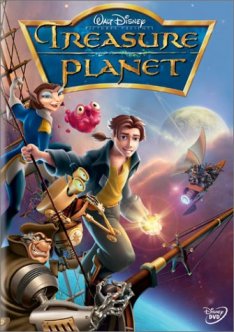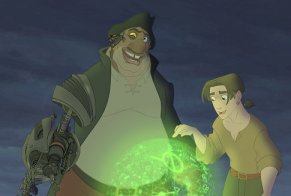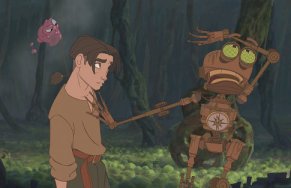RLS Legacy
Treasure Hunt
Choice
Scene: As it should be, Long John Silver's first appearance.
Tech
Specs: Widescreen, aspect ratio 1.66:1, English Dolby
DTS 5.1 surround sound, THX Certified, French and Spanish
language tracks
Making
an animated film aimed squarely at young teen boys is easy.
The hard part is getting those boys to actually go see the
movie. Such has been the case for Disney's two forays into
"boys' adventure," last year's Atlantis:
The Lost Empire and now Treasure Planet.
It's
a shame, too, because directors Ron Clements and John Musker
created a rousing, if somewhat uneven, adventure based on
Robert Louis Stevenson's Treasure Island.
For
a lot of reasons, it was a bold move. The Disney Studios
had already filmed the definitive adaptation, also being
released on DVD today. And though comic books have been
doing it for years, movie audiences have not gotten used
to melding science fiction with history. Though not quite
steampunk, Treasure Planet takes a lot of risks with
its "70/30" ratio of 19th Century appearances and space
age technology.
So
in order for the film to work, you have to give over to
the idea that great galleons soar through open space, with
crewmembers scuttling about their solar sails. Cyborgs exist
in a society based on Georgian England. And pirates fly
a six-eyed skull and crossbones.
While
many of us don't have a problem with that sort of thing,
Treasure Planet still made little impact at the box
office. Had it been live-action, it might have fared better.
But with its release on DVD, you have the opportunity to
take a closer look at a gorgeous achievement in animated
adventure.
Admittedly,
it doesn't always work, occasionally completely ignoring
some rules of science while paying close attention to the
details of others. (A space-dinghy trip through a comet's
tail leaves Long John Silver and hero Jim Hawkins frosted,
as might actually happen, except for that pesky no explanation
for how they survive the vacuum of space.)
By the
time it reaches its third act, however, such problems are
easily put aside as it thunders toward its finish. The film
is a finely crafted labor of love, and Disney's DVD treatment
reflects its artistic worth.
As
has become de rigeur for the studios' high profile
releases, Treasure Planet gets the THX-Certification
treatment. The 5.1 Dolby audio is, of course, sharp. And
the print transfer loses nothing in the subtle hues that
Musker and Clements used in their palette.
That
color is a key element, as both the directors and head of
animation Roy Disney point out. As Atlantis worked
mightily to ape the work of its main designer, Mike Mignola,
Treasure Planet owes a heavy debt to The Brandywine
School, a turn of the 19th century style of illustration.
One of its most famous examples would be N.C. Wyeth's illustrations
for Treasure Island, and in a small gallery sampling
those works, you can see how well the filmmakers captured
the feel of that art.
All
the background information is top-notch, without being overwhelming.
This is not an exhaustive look behind-the-scenes, but just
enough to give an appreciation of the work involved.
Disney
allows you to sort through the information in three different
methods. My favorite is "visual commentary," in which you
get audio commentary that branches out to the various features
referenced. Just in case you don't want to stop the film
dead to watch John Rzeznik's music video (surprisingly good,
though), you can just sort through the extras on your own.
However,
with the deleted scenes, it helps to be able to do a direct
comparison. And such an extra is a rarity. Though not fully
animated, the "lost" sequences are more complete than usual,
and provide an interesting lesson in how a seemingly small
decision can change the whole tone of a film. The original
prologue, though utilizing much of the same footage as ended
up in the finished film, has a much darker tone that the
filmmakers were afraid to allow. Though intended for a slightly
older audience, it's still a Disney film.
Roy
Disney carries that message through his section of the extras.
Serving as the last voice of historical authority in the
studio, Walt's nephew can be a little dry in his narration,
but is always informational.
But
it's not just about the animation. Making a welcome return
to Disney DVD, the studio revives the Disneypedia, a section
for kids that provides historical background to piracy.
Lightly animated and narrated by a friendly child, it may
seem a little bit like a "check your local library" piece,
but you know, there's nothing wrong with that. We encourage
reading books here, after you've read Fanboy Planet.
Also
for the kids: the set-top game. Sensing the raised bar by
Warner Brothers on their Chamber
of Secrets
DVD, Disney has pushed the capabilities of the set-top
game to the limits, with one of their most complex sets
ever. It's also more than a simple trivia game, placed in
the midst of an exploration of the RLS Legacy, the ship
from the film. Kids might not even realize they're actually
learning something about history while playing. Clever,
Disney, clever.
The
game can be hard to get out of, however. And that's not
because it's so absorbing, but because the controls don't
allow it. Each feature of the disc tends to be a one-way
street. Once you're on a path, you have to follow it through,
which can lead to frustration. You may find yourself stopping
and restarting the disc more than you intended. Or just
plan your journey ahead.
Treasure Planet
Treasure Island








